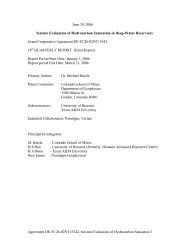Upgrading of Low-Rank Coals - National Energy Technology ...
Upgrading of Low-Rank Coals - National Energy Technology ...
Upgrading of Low-Rank Coals - National Energy Technology ...
Create successful ePaper yourself
Turn your PDF publications into a flip-book with our unique Google optimized e-Paper software.
Alternative Coal Testing<br />
In addition to Buckskin coal, ENCOAL<br />
tested two other coals. Beginning in November<br />
1995, 3,280 tons <strong>of</strong> North Rochelle mine<br />
subbituminous coal was processed at the<br />
same plant parameters as those used for<br />
Buckskin coal. The plant performed well,<br />
but high ash content in the feed coal limited<br />
increases in heating value, the fines rate<br />
was doubled, and the CDL yield was lower<br />
than predicted. The coal processed did not<br />
appear to be representative <strong>of</strong> the overall<br />
mine quality.<br />
A second alternative coal test took place<br />
in December 1996, when the ENCOAL<br />
plant processed approximately 3,000 tons<br />
<strong>of</strong> Wyodak coal, and the Black Hills Corporation<br />
reciprocated with a test burn <strong>of</strong><br />
a mixture <strong>of</strong> PDF fines and ROM coal.<br />
Results from the tests will be analyzed<br />
and used to determine the viability <strong>of</strong> a<br />
The Clean Coal <strong>Technology</strong> (CCT)<br />
Program is a unique partnership between<br />
the federal government and<br />
industry that has as its primary goal<br />
the successful introduction <strong>of</strong> new<br />
clean coal utilization technologies into<br />
the energy marketplace. With its roots<br />
in the acid rain debate <strong>of</strong> the 1980s,<br />
the program is on the verge <strong>of</strong> meeting<br />
its early objective <strong>of</strong> broadening the<br />
range <strong>of</strong> technological solutions available<br />
to eliminate acid rain concerns<br />
associated with coal use. Moreover,<br />
the program has evolved and has been<br />
expanded to address the need for new,<br />
high-efficiency power-generating technologies<br />
that will allow coal to continue<br />
to be a fuel option well into the<br />
21st century.<br />
Begun in 1985 and expanded in<br />
1987 consistent with the recommendation<br />
<strong>of</strong> the U.S. and Canadian Special<br />
commercial plant sited at the Wyodak mine.<br />
Alaskan subbituminous coal, North<br />
Dakota lignite and Texas lignites have also<br />
been laboratory tested. For North Dakota<br />
lignite, laboratory testing was carried out<br />
in two stages over a four-year span. In 1992,<br />
a blend <strong>of</strong> two seams <strong>of</strong> Knife River lignites<br />
was tested at the TEK-KOL Development<br />
Center, where an analysis procedure has<br />
been developed to predict applicability <strong>of</strong><br />
the LFC process to different coals. In 1996,<br />
Freedom mine and Knife River lignite<br />
samples were strength tested to determine<br />
which coals were more suitable for processing.<br />
The 1992 tests verified the applicability<br />
<strong>of</strong> the LFC process, while the 1996<br />
strength tests indicated that the lignite<br />
would not break down excessively during<br />
processing.<br />
Because the laboratory tests <strong>of</strong> these<br />
lignites appeared promising, ENCOAL<br />
The Clean Coal <strong>Technology</strong> Program<br />
Envoys on Acid Rain, the program has<br />
been implemented through a series<br />
<strong>of</strong> five nationwide competitive solicitations.<br />
Each solicitation has been<br />
associated with specific government<br />
funding and program objectives. After<br />
five solicitations, the CCT Program<br />
comprises a total <strong>of</strong> 40 projects<br />
located in 18 states with a capital<br />
investment value <strong>of</strong> nearly $6.0 billion.<br />
DOE’s share <strong>of</strong> the total project costs<br />
is about $2.0 billion, or approximately<br />
34 percent <strong>of</strong> the total. The projects’<br />
industrial participants (i.e., the non-<br />
DOE participants) are providing the<br />
remainder—nearly $4.0 billion.<br />
Clean coal technologies being demonstrated<br />
under the CCT Program are<br />
establishing a technology base that<br />
will enable the nation to meet more<br />
stringent energy and environmental<br />
goals. Most <strong>of</strong> the demonstrations are<br />
being conducted at commercial scale,<br />
in actual user environments, and<br />
under circumstances typical <strong>of</strong> commercial<br />
operations. These features<br />
allow the potential <strong>of</strong> the technologies<br />
to be evaluated in their intended commercial<br />
applications. Each application<br />
addresses one <strong>of</strong> the following four<br />
market sectors:<br />
• Advanced electric power<br />
generation<br />
• Environmental control devices<br />
• Coal processing for clean fuels<br />
• Industrial applications<br />
Given its programmatic success,<br />
the CCT Program serves as a model<br />
for other cooperative government/<br />
industry programs aimed at introducing<br />
new technologies into the<br />
commercial marketplace.<br />
9

















